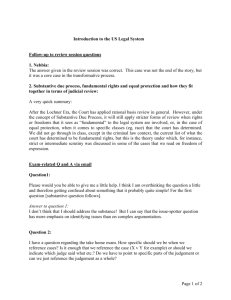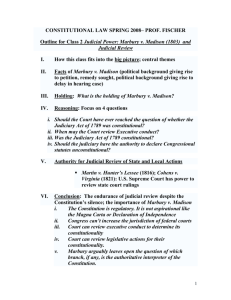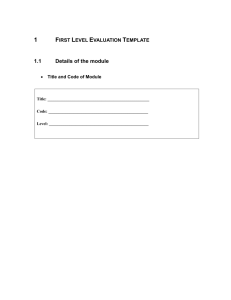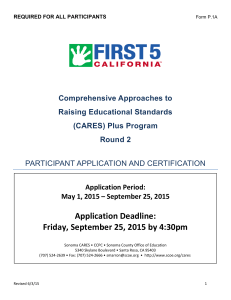STUDENT INFORMATION FOR THE THE FREE RESPONSE
advertisement
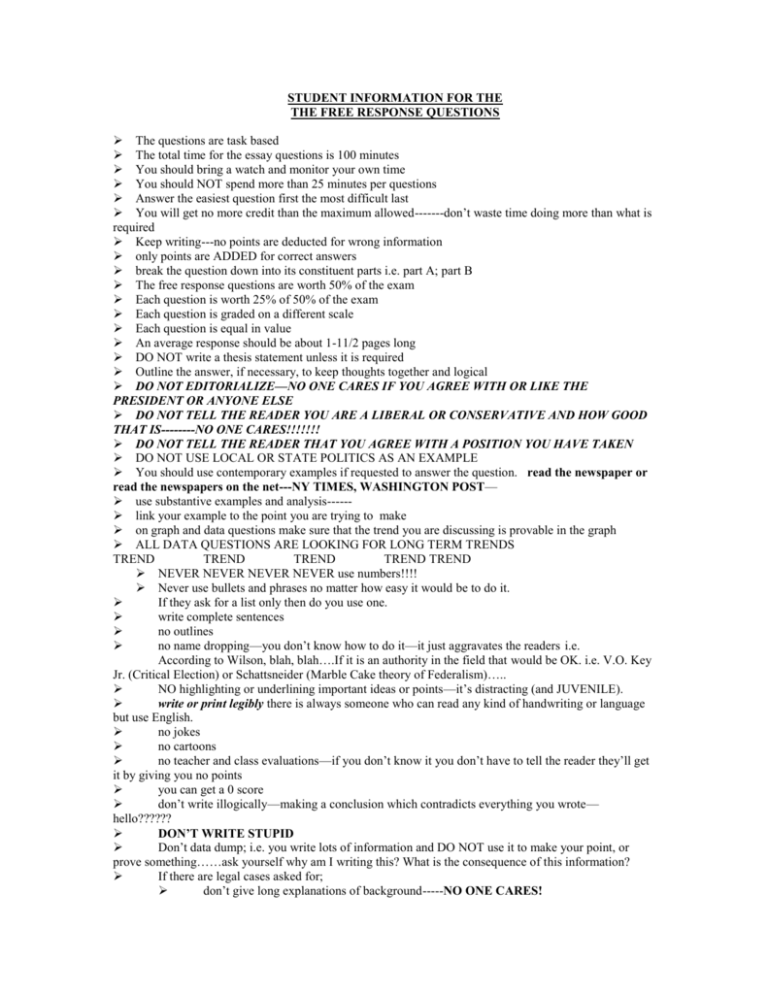
STUDENT INFORMATION FOR THE THE FREE RESPONSE QUESTIONS The questions are task based The total time for the essay questions is 100 minutes You should bring a watch and monitor your own time You should NOT spend more than 25 minutes per questions Answer the easiest question first the most difficult last You will get no more credit than the maximum allowed-------don’t waste time doing more than what is required Keep writing---no points are deducted for wrong information only points are ADDED for correct answers break the question down into its constituent parts i.e. part A; part B The free response questions are worth 50% of the exam Each question is worth 25% of 50% of the exam Each question is graded on a different scale Each question is equal in value An average response should be about 1-11/2 pages long DO NOT write a thesis statement unless it is required Outline the answer, if necessary, to keep thoughts together and logical DO NOT EDITORIALIZE—NO ONE CARES IF YOU AGREE WITH OR LIKE THE PRESIDENT OR ANYONE ELSE DO NOT TELL THE READER YOU ARE A LIBERAL OR CONSERVATIVE AND HOW GOOD THAT IS--------NO ONE CARES!!!!!!! DO NOT TELL THE READER THAT YOU AGREE WITH A POSITION YOU HAVE TAKEN DO NOT USE LOCAL OR STATE POLITICS AS AN EXAMPLE You should use contemporary examples if requested to answer the question. read the newspaper or read the newspapers on the net---NY TIMES, WASHINGTON POST— use substantive examples and analysis----- link your example to the point you are trying to make on graph and data questions make sure that the trend you are discussing is provable in the graph ALL DATA QUESTIONS ARE LOOKING FOR LONG TERM TRENDS TREND TREND TREND TREND TREND NEVER NEVER NEVER NEVER use numbers!!!! Never use bullets and phrases no matter how easy it would be to do it. If they ask for a list only then do you use one. write complete sentences no outlines no name dropping—you don’t know how to do it—it just aggravates the readers i.e. According to Wilson, blah, blah….If it is an authority in the field that would be OK. i.e. V.O. Key Jr. (Critical Election) or Schattsneider (Marble Cake theory of Federalism)….. NO highlighting or underlining important ideas or points—it’s distracting (and JUVENILE). write or print legibly there is always someone who can read any kind of handwriting or language but use English. no jokes no cartoons no teacher and class evaluations—if you don’t know it you don’t have to tell the reader they’ll get it by giving you no points you can get a 0 score don’t write illogically—making a conclusion which contradicts everything you wrote— hello?????? DON’T WRITE STUPID Don’t data dump; i.e. you write lots of information and DO NOT use it to make your point, or prove something……ask yourself why am I writing this? What is the consequence of this information? If there are legal cases asked for; don’t give long explanations of background-----NO ONE CARES! what was the ruling in the case---the legal answer to the legal question. Marbury v Madison the Supremes cannot be given the power to issue writs of mandamus by the congress; it violates delegates potestas non potest delegari (the delegated powers cannot be delegated) what effect did the case have? Marbury v Madison established judicial review of federal law In Brown v Bd Ed no one cares about the 7 students; what matters is the principle of racial classification causing inherent inferiority of one race to the other, thus segregation violates the equal protection clause of the 14th amendment The Cases you need to know by name: Marbury v Madison McCulloch v MD Dartmouth College v Woodward Gibbons v Ogden Buckley v Valeo Baker v Carr U.S. v Nixon Clinton v NY Plessy v Ferguson Brown v Bd. Brown II Swann v Charlotte Mecklenburg CA v Bakke Schenck v NY Gitlow v NY NY Times v U.S. Row v Wade Webster v R.H.S. Engle v Vitali Miranda v Arizona Gideon v Wainright Mapp v Ohio You need to know the following rules: clear & present danger prior restraint compelling interest test wall of separation defacto & dejure segregation reasonable expectation of privacy non-incorporation, partial incorporation exclusionary rule right of privacy fundamental rights


